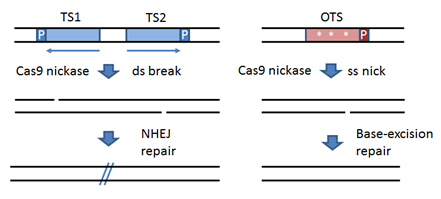A crisper CRISPR: safer genome modification

CRISPR is a molecular tool that edits the genomes of cells and organisms. The technology uses the DNA-cutting enzyme Cas9, with the help of a guide RNA sequence, to find and modify genetic targets.
Previously, researchers used a Cas9 endonuclease, an enzyme that cuts through both strands of DNA. Broken DNA strands can lead to new genetic mutations at the desired site but also at other related sites. In this study, the team found that by using a Cas9 enzyme that nicks a single strand of DNA, known as nickase, they can reduce unplanned, off-target DNA cuts elsewhere in the genome.
“The initial excitement around CRISPR technology has been tempered by recent studies showing significant damage at related sites of the genome. We’ve solved this problem by using a form of Cas9 enzyme that doesn’t break DNA, except at the intended target. The improvement in specificity is remarkable.”
Dr Bill Skarnes Senior author from the Wellcome Trust Sanger Institute
To determine the safest and most efficient option for DNA modification in mouse models, the team compared results with the Cas9 endonuclease, inducing double strand breaks on DNA, and the Cas9 nickase, inducing single strand nicks.
“The Cas9 endonuclease causes double strand breaks at related sites of the genome and these cannot be repaired – this is a real problem for CRISPR technology. Because the Cas9 nickase breaks DNA only at target sites that are close together opposite strands of DNA, off-target nicks at related sequences are easily repaired.”
Dr Wensheng Zhang Co-first author from the Wellcome Trust Sanger Institute
The team used the Cas9 nickase to make a genetic deletion on three genes in mice. Because they targeted two genes very close together – Rag1 and Rag2 – they were also able to successfully create a large deletion. The nickase successfully created cuts on both strands of DNA with no evidence of off-target damage elsewhere.
“This system greatly reduces the risk of off-target mutations in the genomes of mouse models and doesn’t seem to compromise the efficiency of the previous system. It’s amazing to think that this strategy could potentially be applied to alter the genome of any organism.”
Dr Xingxu Huang Senior author from Model Animal Research Center of Nanjing University, China
The team have also developed a freely available online resource that matches the correct genetic sequence with the gene you wish to modify through CRISPR technology.
More information
Notes to Editors
Funding
This work was supported by grants from the 973 program and a core grant from the Wellcome Trust.
Participating Centres
- Ministry of Education Key Laboratory of Model Animal for Disease Study, Model Animal Research Center of Nanjing University, Nanjing 210061, China
- Wellcome Trust Sanger Institute, Wellcome Trust Genome Campus, Hinxton, Cambridge CB10 1SA, UK
- Beijing Institute of Genomics, Chinese Academy of Sciences, Beijing 100101, China
Publications:
Selected websites
The Wellcome Trust Sanger Institute
The Wellcome Trust Sanger Institute is one of the world’s leading genome centres. Through its ability to conduct research at scale, it is able to engage in bold and long-term exploratory projects that are designed to influence and empower medical science globally. Institute research findings, generated through its own research programmes and through its leading role in international consortia, are being used to develop new diagnostics and treatments for human disease.
The Wellcome Trust
The Wellcome Trust is a global charitable foundation dedicated to achieving extraordinary improvements in human and animal health. We support the brightest minds in biomedical research and the medical humanities. Our breadth of support includes public engagement, education and the application of research to improve health. We are independent of both political and commercial interests.


